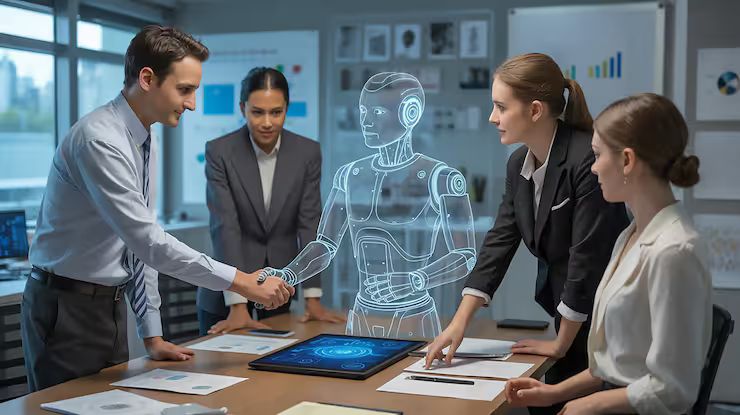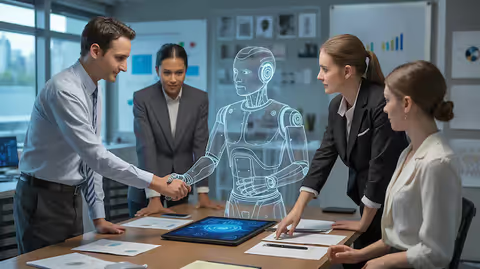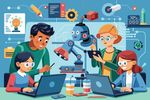
Human-AI Collaboration Guide Practical Tips, Advice, and Detailed Overview of Modern Integration
Human-AI collaboration refers to the partnership between human intelligence and artificial intelligence (AI) systems, where both complement each other instead of one fully replacing the other. AI systems excel at large-scale data processing, pattern recognition, and automation of repetitive tasks, while humans contribute creativity, ethical judgment, and emotional intelligence.
The idea exists because as AI technologies mature particularly through advancements in large language models and autonomous systems organizations realize the greatest value comes not from automation alone, but from augmentation. The focus has shifted from replacing human effort to enabling humans and machines to work together in harmony.

Instead of asking “AI vs. humans?”, modern practice asks “How can AI and humans collaborate effectively?” This shift has inspired new frameworks, workflows, and best practices for a more symbiotic relationship between humans and AI.
Importance
Human-AI collaboration is transforming how we work, think, and create. It matters because:
-
Efficiency & Effectiveness: AI can handle repetitive or data-intensive tasks, allowing humans to focus on higher-value activities like strategy, design, and decision-making.
-
Innovation & Creativity: AI can suggest ideas, surface insights, and simulate possibilities while humans interpret, adapt, and add emotional or contextual nuance.
-
Workforce Transformation: As AI becomes widespread, skills and job structures evolve. People who can effectively collaborate with AI gain a competitive advantage.
-
Ethics & Trust: Human oversight ensures that AI decisions align with ethical standards, fairness, and transparency.
-
Competitive Edge: Organizations that blend AI with human strengths achieve faster decision-making, improved outcomes, and better adaptability.
Human-AI collaboration solves real challenges by:
-
Preventing automation failures through human supervision.
-
Adding context and meaning to AI-generated outputs.
-
Reducing workload and enabling more human-centric, creative tasks.
-
Balancing technological efficiency with ethical and responsible use.
Recent Updates
The past year has seen major changes in how human-AI collaboration is designed and applied:
-
AI systems are evolving from being mere “assistants” to active “team members.” Many organizations are now integrating AI agents directly into workflow teams.
-
The global trend has shifted from “automation-first” to “augmentation-first,” emphasizing that AI should enhance human capability, not replace it.
-
New collaboration frameworks, such as the “Human-AI Handshake Model,” highlight adaptive learning between humans and AI, enabling more dynamic teamwork.
-
Skills such as critical thinking, emotional intelligence, and prompt literacy are becoming essential for collaborating with AI effectively.
-
Workplace communication platforms are integrating AI agents as conversational collaborators, redefining digital teamwork and communication culture.
These developments indicate that human-AI collaboration is no longer theoretical it’s a practical, evolving strategy driving modern business and productivity.
Laws or Policies
The regulatory environment around human-AI collaboration continues to evolve, emphasizing safety, accountability, and ethics.
In India, the AI Governance Guidelines (2025) outline frameworks for responsible AI deployment. They emphasize inclusivity, fairness, transparency, and the principle of “human-centric AI.” Organizations are encouraged to integrate human oversight and ethical evaluation throughout the AI lifecycle.
The Digital Personal Data Protection Act (2023) and the Information Technology Act (2000) also influence AI collaboration by enforcing data privacy, security, and accountability.
Globally, frameworks such as the Framework Convention on Artificial Intelligence (Council of Europe, 2024) focus on aligning AI with human rights, democracy, and the rule of law.
These policies encourage a balance between innovation and responsibility ensuring that AI works with humans, not around them.
Tools and Resources
Here are practical tools, templates, and resources to strengthen human-AI collaboration:
Government & Learning Resources
-
IndiaAI Portal: Provides AI-related guidelines, updates, and case studies.
-
AI Literacy Courses: Many institutions offer online programs focusing on prompt design, AI ethics, and teamwork with intelligent systems.
Templates & Frameworks
-
AI Risk Assessment Template: Helps identify where human oversight is required in workflows.
-
Human-in-the-Loop Workflow Template: Defines when AI assists and where humans make final decisions.
-
Change-Management Checklists: Guides teams through skill development, trust-building, and communication planning.
Collaboration Tools
-
AI-powered assistants for writing, data analysis, and decision-support.
-
Project management tools that integrate with AI to automate repetitive tracking and reporting.
-
Dashboard and monitoring software for measuring human-AI collaboration success and performance metrics.
Knowledge Resources
-
Research papers on augmented intelligence and hybrid workforce design.
-
Industry reports on AI governance, ethics, and skill evolution.
-
Communities of practice sharing best methods for human-AI teamwork.
These tools and resources can help businesses, educators, and creators build strong, reliable, and ethical human-AI ecosystems.
FAQs
Q1: What is the difference between human-AI collaboration and automation?
Human-AI collaboration focuses on working together — AI assists by analyzing or generating, while humans interpret and finalize. Automation, in contrast, replaces human input entirely. Collaboration blends machine efficiency with human creativity and empathy.
Q2: Which tasks benefit most from human-AI collaboration?
Tasks that combine data and decision-making: research analysis, creative writing, marketing, healthcare diagnostics, customer interaction, and predictive analytics. These tasks need both computational power and human judgment.
Q3: What skills improve human-AI collaboration?
Key skills include understanding AI capabilities, writing effective prompts, critical thinking, evaluating AI outputs, ethical reasoning, and adaptability in evolving workflows.
Q4: What are the main challenges?
Challenges include building trust between humans and AI, integrating AI seamlessly into workflows, managing over-reliance, and ensuring human oversight remains strong. Organizational readiness and clear communication are crucial.
Q5: How is success measured?
Success is tracked using metrics like time saved, accuracy improvement, quality of insights, employee satisfaction, and reduction of repetitive workload. Qualitative feedback also helps gauge effectiveness and comfort with AI tools.
Conclusion
Human-AI collaboration is redefining the future of work, creativity, and innovation. The partnership between human judgment and machine intelligence unlocks new potential for efficiency and discovery.
The modern shift from “replacement” to “augmentation” highlights a critical truth AI performs best when guided by human intent, and humans thrive when supported by intelligent tools. Together, they form a cycle of learning, adaptability, and productivity.
With growing awareness, updated laws, and practical frameworks, the focus is now on creating responsible, transparent, and ethical collaboration. Success in this space will depend on how thoughtfully organizations and individuals design their workflows, develop their skills, and maintain human values in every AI-assisted process.
Ultimately, the future belongs not to AI alone or humans alone but to teams where human creativity and AI intelligence unite for better decisions, stronger innovation, and a more inclusive digital era.






